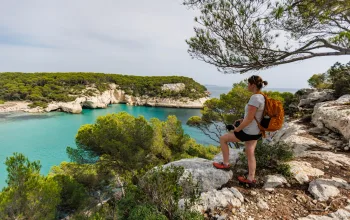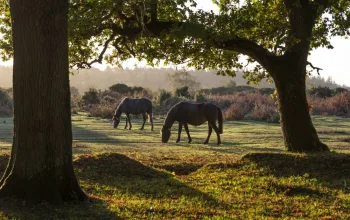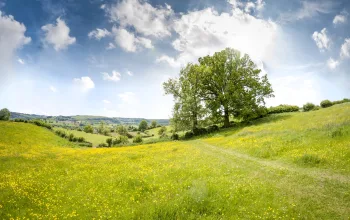It’s my first time in this part of the world, yet it all seems strangely familiar. And I think I know why. Standing here at Flatford Mill in Suffolk is like stepping back in time. I’m on the exact spot where John Constable, one of England’s best-loved landscape painters, would have set up his easel to create what was to become one of Britain’s most iconic paintings.
Voted the second-greatest painting in Britain in a BBC Radio Four survey, The Hay Wain, completed in 1821, is one of a series of pastoral scenes that Constable painted of Dedham Vale and the River Stour. Now forming part of an area of outstanding natural beauty (AONB), the landscapes he painted eventually came to epitomise the English countryside.
‘There’s a real concentration of Constable scenes around here,’ explains Martin Atkinson, National Trust property manager at Flatford Mill, gesturing towards the 16th-century thatched mill cottage. ‘This was one of Constable’s father’s mills, where he spent a lot of time sketching and painting. Almost everywhere you go, you walk past a scene Constable painted. People often walk past without realising.’
Two hundred years on, these scenes remain virtually unchanged. But this is no coincidence. As a popular honey-pot site for the area’s tourists (Dedham and Flatford attract around 220,000 visitors a year), it’s in the National Trust’s interests to maintain the scenes as they appear in the Constable paintings, at least to a degree.
‘What we don’t do is try to fossilise the landscape,’ says Atkinson. ‘What we try to do is keep an impression of the paintings. So with regard to The Hay Wain, we obviously try to make sure that it’s looking similar so you
can get an impression of what it was like when Constable painted it.’
Vital Lifeline
The undulating slopes that descend to meet the River Stour with its hedged water meadows, copses and distinctive pollarded willows were a source of great inspiration not just to Constable, but also to Alfred Munnings and Thomas Gainsborough, both of whom are ‘local lads’ who depicted the region in some of their work.
‘All of these painters tried to capture country life – they really bring East Anglian life alive,’ says Neil Catchpole, the AONB’s landscape and biodiversity officer. ‘But a lot of the inspiration was from the river itself and the trade on it.’
Separating the counties of Suffolk and Essex, the River Stour (pronounced ‘stoor’) was once a vital lifeline for the people of Dedham Vale, powering a series of mills and providing a trade route upon which to transport goods
to London. Designated in 1970, the Dedham Vale AONB encompasses 90 square kilometres from the outskirts
of the village of Bures in Suffolk downstream to Manningtree in Essex.
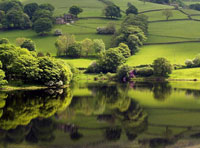 ‘One of the overriding things that you have to think of when you’re talking about this AONB is the fact that it’s a river valley and was once a working river valley,’ says Catchpole. ‘There was an act of parliament in 1705 to create navigation on the River Stour for the purposes of trade. And to this day, anybody has the right to navigate that river (by hand-powered craft) from Sudbury right through to the sea.’
‘One of the overriding things that you have to think of when you’re talking about this AONB is the fact that it’s a river valley and was once a working river valley,’ says Catchpole. ‘There was an act of parliament in 1705 to create navigation on the River Stour for the purposes of trade. And to this day, anybody has the right to navigate that river (by hand-powered craft) from Sudbury right through to the sea.’
At its height during the mid-19th century, the river would have looked very different to today, with dozens of Stour ‘lighters’ gliding up and down it throughout the day. A type of shallow-hulled open wooden barge, lighters were often lashed together in tandem and towed by a single horse, which was trained to leap on and off the foredeck as the towpath changed sides – a local phenomenon captured by Constable in The White Horse.
As with most inland waterways, the advent of the steam engine marked the beginning of the end for the River Stour’s fleet of lighters, and the last barge came up the river to Dedham in 1930. But there are still signs of the old wharfs and locks, many of which have been painstakingly restored or maintained by the River Stour Trust.
Today, the river is used just for pleasure. ‘The beauty of it is that if you get on the river, you can see the valley from a different perspective completely,’ says Catchpole. ‘There are fallen trees, and lots of secret places – it’s all a bit Swallows and Amazons.’
Dedham as a Dormouse
While the Stour undoubtedly exerts a great influence over the character of the AONB, once you turn your back
on it and climb the gentle valley sides, the winding single-track lanes carry you through an ever-changing scene. Cultivated farmland overlooked by quaint timber-framed farmhouses, some with thatched roofs, some with elaborate pargeting (decorative plaster) or flint-worked facades, are divided by ancient hedgerows, patches of ancient woodland and one of the last bastions of ancient grassland in Suffolk.
‘Suffolk has a reputation for being flat,’ says Catchpole. ‘But it isn’t – it’s a gently rolling landscape and we’ve a surprising range of habitat types here.’
At the evocatively named Arger Fen and Spouse’s Vale, two nature reserves on the fringes of the AONB, the Suffolk Wildlife Trust is working to restore one of England most important habitats – ancient woodland – which is home to
a number of rare or threatened species, including the dormouse. Dr Simone Bullion of the Suffolk Wildlife Trust (SWT) explains that dedicated dormouse conservation can benefit a whole ecosystem.
‘Dormice are the pandas of British wildlife: if you get it right for them, you’ll get it right for an awful lot of other things as well,’ she says. ‘If you’re creating the conditions that dormice need – wonderful diversity in their habitat and a good three-dimensional structure – then it’s going to be wonderful for invertebrates, birds, everything else. If you have thriving dormice, you’re going to have thriving everything else.’
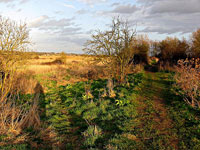 The SWT is working not only to survey dormouse numbers (through the provision of nesting boxes), but also to restore the woodland to its former glory by removing non-native conifers and by linking mosaics of ancient woodland together to boost biodiversity.
The SWT is working not only to survey dormouse numbers (through the provision of nesting boxes), but also to restore the woodland to its former glory by removing non-native conifers and by linking mosaics of ancient woodland together to boost biodiversity.
‘We’ve acquired a new area [between Arger Fen and Spouse’s Vale] that was previously arable farmland but which we’ve left to regenerate naturally – it will eventually become woodland. The whole area comes to 48 hectares, so we have a big land holding, which is great because, with conservation, bigger is better.’
In partnership with the AONB, the SWT is also trying to connect Arger Fen and Spouse’s Vale to another nearby reserve called Tiger Hill, which protects acid grassland. Once common across Suffolk, the habitat supports fine grasses, lichen and mosses, while the adjacent ancient woodland is home to badgers, dormice, owls, pipistrell bats, and more. What’s curious about the grassland here is the bobbled, lumpy appearance and feel of it underfoot – it’s like walking on a piece of giant bubble wrap.
‘Anthills,’ says Catchpole, anticipating my next question. ‘These are the most magnificent anthills you’ll ever see – they’re still inhabited and get bigger every year. As far as we know, this area has never been ploughed, it has only been grazed – it’s a bit of old England.’
The AONB team is planning to introduce sheep on the grassland on a semi-permanent basis to stave off the ever-encroaching scrub and give the grassland plant species a chance.
It’s heartening to see that such a culturally, historically and biologically important slice of old England being preserved through these and dozens of similar projects, which will ensure that Dedham Vale can continue to be a source of inspiration, as it was for the area’s most famous resident.
‘The sound of water escaping from mill-dams, [the] willows, old rotten planks, slimy posts and brickwork, I love such things…’ wrote Constable in a letter to a friend. ‘Those scenes made me a painter and I am grateful.’
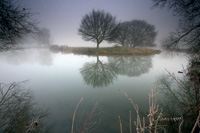 Local Knowledge the best places in Dedham Vale to...
Local Knowledge the best places in Dedham Vale to...
Take tea after a walk
‘Dedham has a real community feel to it and lots of connections to Constable – one of his paintings is hung inside the church, you can see his initials etched on his old school and there’s a
top tea shop, which is great after the walk from Flatford or along the river – it’s a really lovely place to be.’
Cathy Smith, communications officer, Dedham Vale AONB
Enjoy a great view
‘My favourite place in the whole valley is the view from the old black barn just below the church in Wormingford.
It opens up one of the best views across the valley – you can see all the different habitats laid out below you. It also looks over the house that we have lived in for 25 years where we brought up our family in the valley that I love.’
Neil Catchpole, AONB landscape and biodiversity officer
Enjoy local fayre
‘The Crown Inn in Stoke by Nayland has a fine reputation for great local food and an impressive wine list. They’ve also recently developed 11 superb guest bedrooms so it’s like a countryside boutique hotel in the heart of Constable Country.’
Jim Brown, Choose Suffolk Tourism
See the wild woods
‘The best place to see ancient woodland in the AONB is, in my opinion, Arger Fen, which connects
to Spouse’s Vale. It’s a large area and you can walk through it for quite
a distance experiencing a taste of what it might have been like in the wild woods. It’s a fantastic spot for bluebells in the springtime, too.’
Simone Bullion, senior conservation officer, Suffolk Wildlife Trust


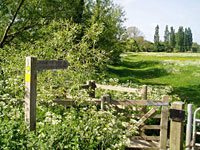 Straddling the counties of Essex and Suffolk, Dedham Vale AONB is in the heart of Constable Country, a rural idyll of sleepy farming villages that provided a wealth of inspiration for one of Britain’s favourite landscape painters. Natalie Hoare reports from the quintessential English countryside.
Straddling the counties of Essex and Suffolk, Dedham Vale AONB is in the heart of Constable Country, a rural idyll of sleepy farming villages that provided a wealth of inspiration for one of Britain’s favourite landscape painters. Natalie Hoare reports from the quintessential English countryside.

